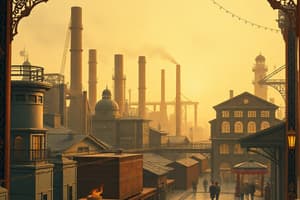Podcast
Questions and Answers
What was the Gilded Age characterized by?
What was the Gilded Age characterized by?
- Agricultural development and peaceful coexistence
- Political transparency and equality for all
- Wealth and corruption, economic growth, industrialization, and urbanization (correct)
- Technological stagnation and population decline
What comprised over half of manufacturing workers in 1920?
What comprised over half of manufacturing workers in 1920?
- African Americans
- Native-born Americans
- Immigrants and their descendants (correct)
- Women and children
What marked the end of the Gilded Age and its rigid class structure?
What marked the end of the Gilded Age and its rigid class structure?
- Expansion of railroads and communication
- Economic growth and industrialization
- Beginning of organized labor, investigative journalism, and progressive ideologies (correct)
- Political corruption and patronage
What did the Civil Service Act seek to curb?
What did the Civil Service Act seek to curb?
What was a significant characteristic of the Gilded Age?
What was a significant characteristic of the Gilded Age?
What did the Interstate Commerce Act seek to end?
What did the Interstate Commerce Act seek to end?
What was a central subtopic of the Gilded Age?
What was a central subtopic of the Gilded Age?
What was the mainstay of the American industrial workforce in 1920?
What was the mainstay of the American industrial workforce in 1920?
What did the Progressive Era seek to address?
What did the Progressive Era seek to address?
What characterized the size and selectivity of the immigrant community during the Gilded Age?
What characterized the size and selectivity of the immigrant community during the Gilded Age?
Flashcards are hidden until you start studying
Study Notes
The Gilded Age, a term coined by Mark Twain and Charles Dudley Warner, referred to the late 19th century as an era of wealth and corruption, characterized by economic growth, industrialization, and urbanization The Gilded Age was marked by the creation of a modern industrial economy, the expansion of railroads, the mechanization of industry, and the growth of communication However, this period was also marked by political corruption, labor movements, and immigration.
Immigration was a central subtopics of the Gilded Age. The 1880s saw the first decade of American urbanization and immigration Immigrants and their descendants comprised over half of manufacturing workers in 1920, and they were the mainstay of the American industrial workforce The size and selectivity of the immigrant community, as well as their disproportionate residence in large cities, meant they were the mainstay of the American industrial workforce
The Gilded Age was also marked by industrialization, which brought about technological changes and economic growth However, this period was also marked by economic devastation and dangerous working conditions for labor The beginning of organized labor, investigative journalism, and progressive ideologies began to spell the end of the Gilded Age and its rigid class structure
The Gilded Age was also marked by political corruption and patronage Political machines controlled governments at the state and local levels, and corruption did not stop at the federal level The Civil Service Act sought to curb government corruption by requiring applicants for certain governmental The Interstate Commerce Act sought to end discrimination by railroads against small shippers and the The Progressive Era, which began in the late 19th century, was marked by reforms that sought to address these societal and economic
Studying That Suits You
Use AI to generate personalized quizzes and flashcards to suit your learning preferences.




